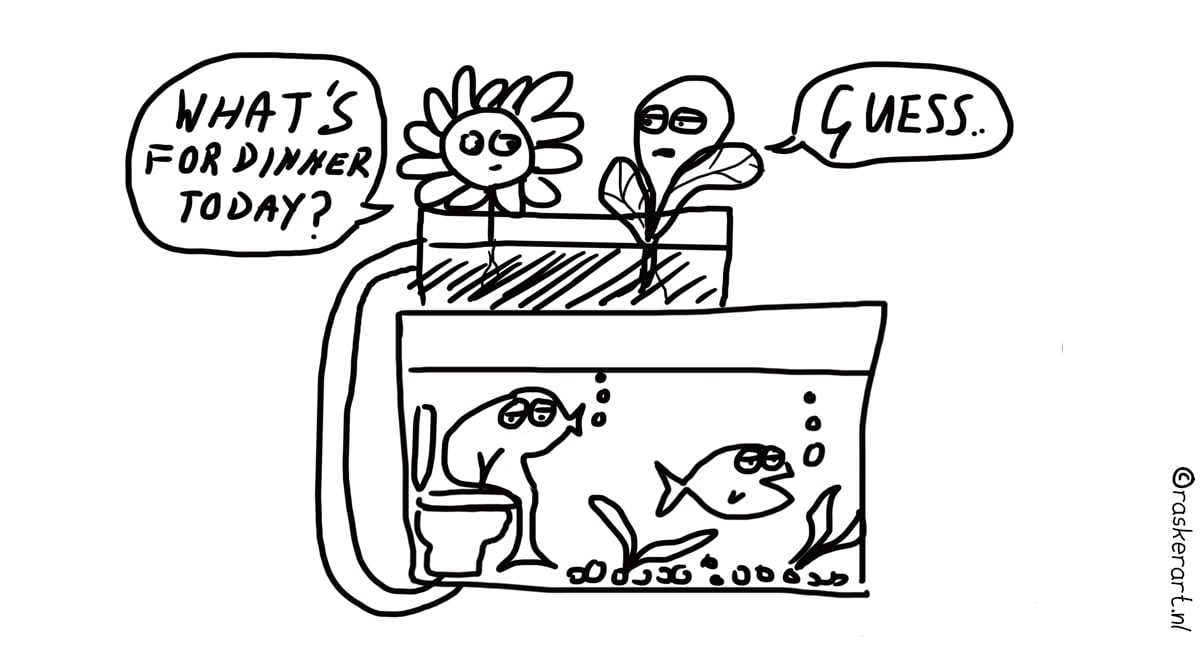
As early as the early 1990s, Adri Bout had already realized that fishing ‘would become a niche, something quite special’. Bout managed to set up a successful fish farm after plenty of trial and error. The whole world wants to learn from him what his formula for success is. “People who think that this formula can just simply be copied are mistaken”, he explained in last week’s best-read story.
One other way to farm fish and grow vegetables at the same time is aquaponics. Whereby fish manure is used to feed plants. Jos Hakkenes grows his own fish and vegetables on the fifth floor of an old Philips building in Eindhoven. He has about four hundred square meters at his disposal to grow all kinds of lettuce and other leafy vegetables. No vast production like that of Bout in Zeeland, instead rather small-scale. “I want to show that you can also grow food in other ways,” says Hakkenes.
Herbs, leafy vegetables and various types of lettuce grow under a purple glow. The plants float on a type of bed which has holes in it. The first rows are empty. They’re freshly harvested. There are LED grow lights above them. The lettuce draws nutrients from the water that flows through the four large fish tanks under the floating crops. The water passes through a biofilter before it goes there. This filter sprays extra air near the water and filters uneaten fish food or other coarse leftovers. The worms and other bacteria in the plant beds convert the fish feces from the water to nitrate, which in turn feeds the plants. Once the plants have absorbed this, the clean water flows back to the trout.
Think about alternatives
According to Hakkenes, aquaponics is an ideal system for growing food with a minimum of waste: “Agriculture is very efficient, except that it’s a linear system. It has many adverse side effects and there is a lot of wastage. If you also count the pesticides that damage the natural ecosystem of insects and soil that is completely depleted, then you start to think about alternatives. Aquaponics is definitely one such sustainable alternative.”
It’s a circular system, Hakkenes explains. The water of the fish flows right around. Once the plants have absorbed the nutrients, the water goes back to the tanks. “I use 90% less water than conventional growers who work in fields. Moreover, the crop grows twice as fast, because the nutrients don’t have to be shared with weeds.”
“The food the fish are fed is free of growth hormones, antibiotics and other drugs. We do not use any pesticides. The idea is that nature should go its own way as much as possible,” Hakkenes adds.
But that takes time, because the system has to be balanced before aquaponics can work properly. You can have a shortage of fish, so the plants don’t get enough nourishment and don’t grow well, or even worse, die. But you can also have too much fish for too few plants. Consequently, the water fills up with manure and flows back into the fish tank. Then you have to start all over again from scratch. Hakkennes: ‘I’ve found dead fish more than once when I’ve walked in. Bacteria in the plant beds cause ammonia to turn into nitrite and then into nitrate. But if this isn’t absorbed – or is absorbed insufficiently because there aren’t enough plants, these substances go back to the fish tanks where the fish can’t cope with them.”
Seeking balance
“It’s always about trying to find the right balance. Constantly checking levels, gradually building things up.” Greenhouses where they can determine plant nutrition up to five decimal places with their equipment – Hakkennes views these with a critical eye. “Well, I could do it that way, too. But we use an ecological system. Bacteria that occur in nature do the work. I don’t use any pesticides either.”
Hakkenes doesn’t think that his method is suitable for feeding the entire Netherlands. “Not likely. It’s difficult to earn a profit in our country. Vegetables are cheap and we’re a real agricultural country. Agriculture is a money-maker when it’ s on a massive scale. We aren’t able to match that quantity. The whole structure of agriculture should change, yet I don’t see that happening any time soon.”
Nevertheless, he is convinced that things can be done differently: ‘Linear systems, like our current agriculture, have run their course. Permacultures have the future. Already we’re showing that we can run production without any negative side effects.”


